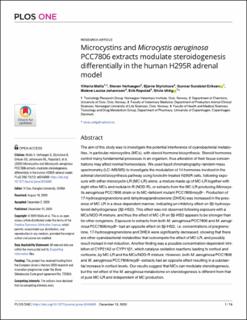| dc.description.abstract | The aim of this study was to investigate the potential interference of cyanobacterial metabolites, in particular microcystins (MCs), with steroid hormone biosynthesis. Steroid hormones control many fundamental processes in an organism, thus alteration of their tissue concentrations may affect normal homeostasis. We used liquid chromatography–tandem mass spectrometry (LC–MS/MS) to investigate the modulation of 14 hormones involved in the adrenal steroid biosynthesis pathway using forskolin-treated H295R cells, following exposure with either microcystin-LR (MC-LR) alone, a mixture made up of MC-LR together with eight other MCs and nodularin-R (NOD-R), or extracts from the MC-LR-producing Microcystis aeruginosa PCC7806 strain or its MC-deficient mutant PCC7806mcyB−. Production of 17-hydroxypregnenolone and dehydroepiandrosterone (DHEA) was increased in the presence of MC-LR in a dose-dependent manner, indicating an inhibitory effect on 3β-hydroxysteroid dehydrogenase (3β-HSD). This effect was not observed following exposure with a MCs/NOD-R mixture, and thus the effect of MC-LR on 3β-HSD appears to be stronger than for other congeners. Exposure to extracts from both M. aeruginosa PCC7806 and M. aeruginosa PCC7806mcyB− had an opposite effect on 3β-HSD, i.e. concentrations of pregnenolone, 17-hydroxypregnenolone and DHEA were significantly decreased, showing that there are other cyanobacterial metabolites that outcompete the effect of MC-LR, and possibly result instead in net-induction. Another finding was a possible concentration-dependent inhibition of CYP21A2 or CYP11β1, which catalyse oxidation reactions leading to cortisol and cortisone, by MC-LR and the MCs/NOD-R mixture. However, both M. aeruginosa PCC7806 and M. aeruginosa PCC7806mcyB− extracts had an opposite effect resulting in a substantial increase in cortisol levels. Our results suggest that MCs can modulate steroidogenesis, but the net effect of the M. aeruginosa metabolome on steroidogenesis is different from that of pure MC-LR and independent of MC production. | en_US |

